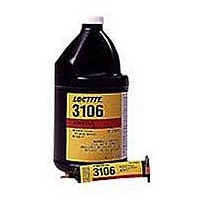PRODUCT DESCRIPTION
LOCTITE
characteristics:
LOCTITE
flexible PVC to polycarbonate where large gap filling
capabilities and flexible joints are desired. The product has
shown excellent adhesion to a wide variety of substrates
including glass, many plastics and most metals. The thixotropic
nature of LOCTITE
product after application to the substrate.
TYPICAL PROPERTIES OF UNCURED MATERIAL
TYPICAL CURING PERFORMANCE
LOCTITE
visible light of sufficient intensity. To obtain full cure on
surfaces exposed to air, radiation @ 220 to 260 nm is also
required. The speed of cure will depend upon the UV intensity
and spectral distribution of the light source, the exposure time
and the light transmittance of the substrates.
Stress Cracking
Technology
Chemical Type
Appearance (uncured)
Components
Viscosity
Cure
Cure Benefit
Application
Flexibility
Liquid adhesive is applied to a polycarbonate bar 6.4 cm by
13 mm by 3 mm which is then flexed to induce a known stress
level.
Specific Gravity @ 25 °C
Refractive Index
Flash Point - See MSDS
Viscosity, Brookfield - RVT, 25 °C, mPa·s (cP):
Stress Cracking, ASTM D 3929, minutes:
7 N/mm² stress on bar
12 N/mm² stress on bar
Spindle 4, speed 20 rpm
®
®
®
3106™ is primarily designed for bonding rigid or
3106™ can be cured by exposure to UV and/or
3106™
®
3106™ reduces the migration of liquid
provides
Acrylic
Acrylated urethane
Transparent liquid
One component - requires no mixing
Medium, thixotropic
Ultraviolet (UV)/ visible light
Production - high speed curing
Bonding
Enhances load bearing & shock
absorbing characteristics of the bond
area.
the
following
LMS
3,500 to 7,500
1.08
1.48
>15
13 to 14
product
LMS
Fixture Time
Depth of Cure vs. Irradiance (365 nm)
The graph below shows the increase in depth of cure with time
at 50mW/cm² - 100mW/cm² as measured from the thickness
of the cured pellet formed in a 15mm diameter PTFE die.
Note: When exposed to a V Bulb at irradiances of 50 and 100
mW/cm² for 30 seconds, a depth of cure greater than 13 mm
was achieved. The performance for medium pressure Hg will
be similar to Electrodeless system, H bulb
Curing System: Metal Halide
Fixture time is defined as the time to develop a shear strength
of 0.1 N/mm².
UV Fixture Time, Glass microscope slides, seconds:
UV Fixture Time, Polycarbonate to PVC, seconds:
Black light, Zeta
Metal halide bulb, Zeta
Electrodeless, H & V bulbs:
Electrodeless, D bulb:
6 mW/cm², measured @ 365 nm
30 mW/cm², measured @ 365 nm,
50 mW/cm², measured @ 365 nm,
50 mW/cm², measured @ 365 nm,
14
12
10
8
6
4
2
0
0
LOCTITE
10
®
7500 light source:
®
7400:
20
30
®
Technical Data Sheet
40
3106™
50
≤15
<5
<5
<5
April-2007
LMS
60



